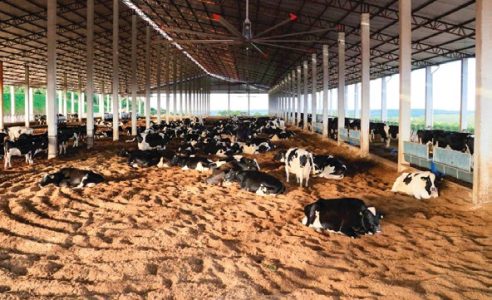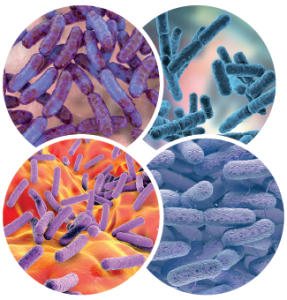 06 Dec 2022
06 Dec 2022
Considering that feed costs contribute up to 60% of production costs within dairy production, improving feed-to-milk efficiency can have a significant impact on dairy profitability .
There are several approaches to estimating feed efficiency in dairy cattle. One of these is the estimation of net feed efficiency, called Residual Feed Intake (RFI), and the challenges associated with its use to improve the feeding efficiency of growing heifers and lactating cows.
Higher production per cow reduces the number of animals which are needed to produce the same amount of milk. This translates into:
![]() Savings in feed costs
Savings in feed costs
![]() Reducing the use of natural resources
Reducing the use of natural resources
![]() Reduced carbon footprint associated with dairy production (Capper et al., 2009).
Reduced carbon footprint associated with dairy production (Capper et al., 2009).
Dairy production requires an initial time and investment of resources for heifer breeding prior to achieving a saleable dairy product.

Even more so, during their typical dry period of 60 days, cows consume feed without contributing to income. In fact, Schutz (2002) estimates that about 23% to 28% of the total dry matter (DM) consumption of the herd is carried out by non-lactating animals.
Therefore, there are opportunities to save on feed costs during these non-productive periods. Employing better herd management practices while only keeping those animals which are most efficient.
Estimating feed efficiency in dairy cattle
[register]Multiple terms have been used to define feed efficiency in dairy cattle. The simplest of which is GFE, expressed as:
“The relationship between milk production and feed input.”
Total milk is normally standardized to milk components such as solid- or energy-corrected milk production.
Alternatively, the efficiency of specific dietary nutrients can also be assessed. For example protein efficacy is calculated as:
“Milk protein yield per amount of CP intake”.
GFE (expressed as milk production over feed input) has a strong positive genetic correlation with milk production (Oldenbroek, 1989; Prendiville et al., 2009; Spurlock et al., 2012), which is already a primary goal of genetic improvement.
Revenue over feed cost (ROFC): Another term used to assess and define dairy feed efficiency examines efficiency directly from a profitability standpoint and is known as feed cost income, also called return on feed (ROF).
It is calculated as:
“The difference between the total revenue earned from the sale of milk during a selected time interval and the feed costs associated with its production.”
It is a useful tool to monitor the profitability of dairy producers
RFI differs from GFE in that it is designed to estimate the net feed efficiency or metabolic efficiency of the cow.
It is calculated as:
“The difference between the cow’s actual feed intake (or energy consumption) and its expected feed intake (or energy consumption)”,
Based on a mathematical model that takes into account the energy costs for milk maintenance and production during a certain period.
Although it is less common, intake can also be estimated from table values. For example, those of the National Research Council (NRC, 2001);
Considering that RFI represents the difference between actual consumption and the expected intake required to support maintenance and production; a low or negative RFI value is desirable. This can be a source of confusion which can limit its acceptance among dairy farmers as a target for genetic improvement.
![]() Multiple studies have evaluated the heritability of RFI in both grazing and confined systems of dairy cows during a 305-day lactation period. Reported heritability estimates are generally low to moderate, with values ranging from 0.01 to 0.40 among lactating cows (de Haas et al., 2011; Connor et al., 2012a and 2013) and 0.22 to 0.40 among growing heifers (Pryce et al., 2012; Lin et al., 2013).
Multiple studies have evaluated the heritability of RFI in both grazing and confined systems of dairy cows during a 305-day lactation period. Reported heritability estimates are generally low to moderate, with values ranging from 0.01 to 0.40 among lactating cows (de Haas et al., 2011; Connor et al., 2012a and 2013) and 0.22 to 0.40 among growing heifers (Pryce et al., 2012; Lin et al., 2013).
![]() Finally, low RFI in livestock is potentially associated with decreased manure production per animal, relative to cattle with high RF. This is partly due to to reduced DMI (Basarab et al., 2013; Berry and Crowley, 2013).
Finally, low RFI in livestock is potentially associated with decreased manure production per animal, relative to cattle with high RF. This is partly due to to reduced DMI (Basarab et al., 2013; Berry and Crowley, 2013).

As an alternative to the direct measurement of feed consumption or feed efficiency, indicators such as the use of traits which are genetically correlated with RFI (Berry, 2009) or other values that can be used to predict intake have been suggested (Berry and Crowley, 2013).
For example, a selection index based on the combination of four readily available features:
Genomic selection
If shown to have sufficient accuracy, genomic selection provides the most practical approach to improving feed efficiency because it eliminates the need to collect phenotypic data from each animal in the target population. Which is necessary when using traditional selection tools in order to make genetic progress.
Genomic selection consists of estimating the cumulative effects of a large number of genetic markers placed throughout the genome on the trait of interest (e.g., RFI). Using genotypes and phenotypes which are obtained from a reference population, and then developing a prediction equation which estimates the genetic values for the trait within the target population (Meuwissen et al., 2001).
Rumen microbial populations
Considering that ruminants get most of their dietary energy from volatile fatty acids produced from microbial fermentation of carbohydrates in the rumen; microorganism populations found in the rumen are critical in the regulation of multiple processes that ultimately affect the feeding efficiency of dairy cows.

Feeding behavior and physical activity
Richardson and Herd (2004) suggested that cattle feeding patterns are likely to contribute to ∼2% of the variation in RFI.
– In fact, multiple studies report positive phenotypic correlations between RFI measured during growth and:
![]() feeding rate (amount of food consumed per unit of time)
feeding rate (amount of food consumed per unit of time)
![]() the number of meals consumed per day
the number of meals consumed per day
![]() and time spent feeding each day (Basarab et al. , 2013)
and time spent feeding each day (Basarab et al. , 2013)
Indicating that more efficient animals ate at a slower rate, ate fewer times, and spent less time eating each day compared to those which were less efficient.
Finally,an increased feed passage rate is associated with reduced feed digestibility. Which indicates that a faster feed consumption rate could adversely affect feed digestibility.
Conclusions
Although feed costs contribute up to 60% of total production costs,it is possible to increase the profitability of milk production through genetic selection for greater feed efficiency, both for growing and lactating dairy cattle.
Feed efficiency estimates for dairy cattle have been calculated through various methods. However,a growing number of recent studies are evaluating the use of RFI and its relationship with other production parameters.
[/register]
Subscribe now to the technical magazine of animal nutrition
AUTHORS

Nutritional Interventions to Improve Fertility in Male Broiler Breeders
Edgar Oviedo
The Use of Organic Acids in Poultry: A Natural Path to Health and Productivity
M. Naeem
Synergistic Benefits of Prebiotics and Probiotics in Poultry, Swine, and Cattle
Gustavo Adolfo Quintana-Ospina
Hybrid Rye Potential in Laying Hen Feed Rations
Gwendolyn Jones
A day in the life of phosphorus in pigs: Part I
Rafael Duran Giménez-Rico
Use of enzymes in diets for ruminants
Braulio de la Calle Campos
Minerals and Hoof Health in the Pregnant Sow
Juan Gabriel Espino
Impact of Oxidized Fats on Swine Reproduction and Offspring
Maria Alejandra Perez Alvarado